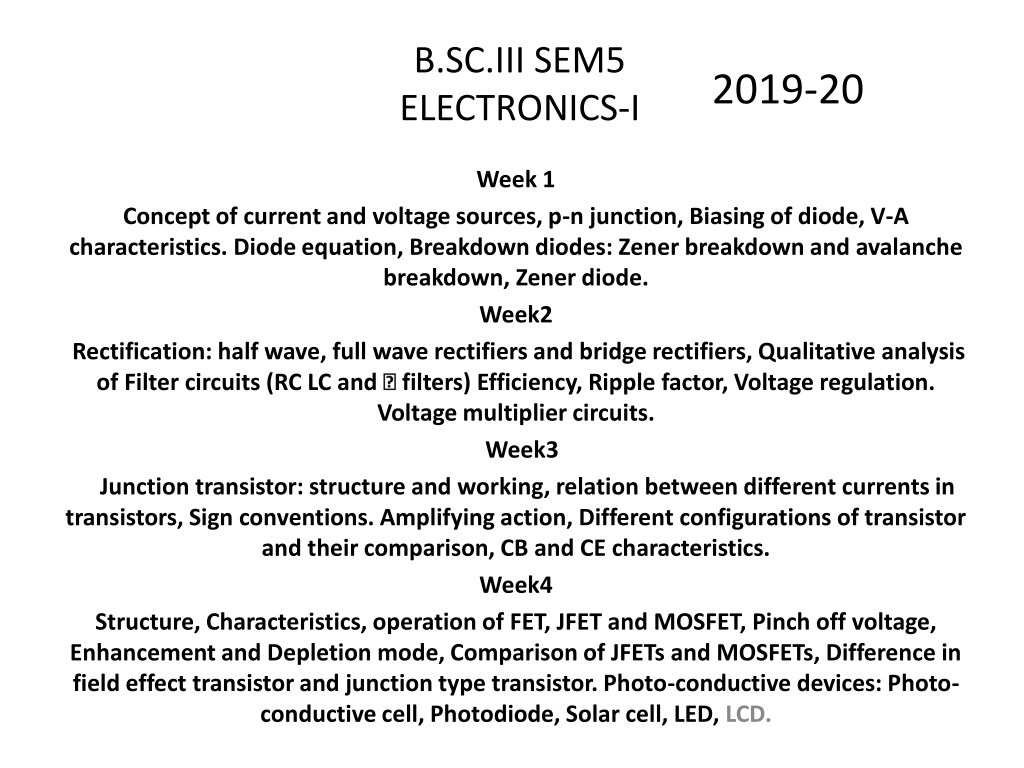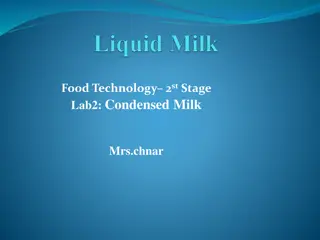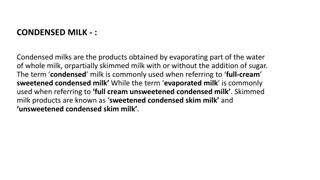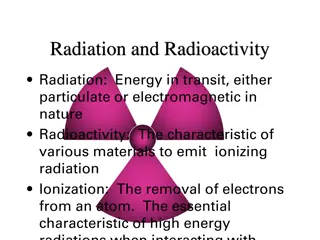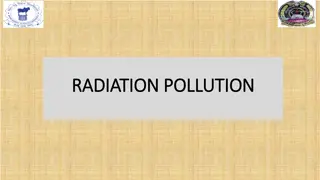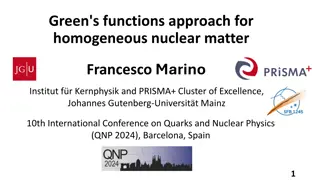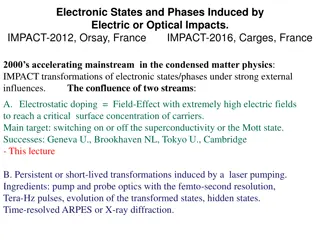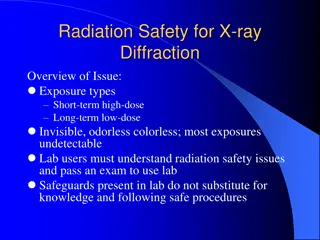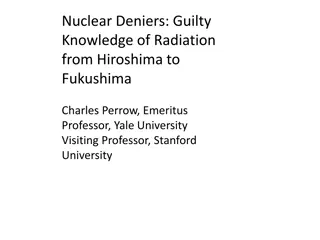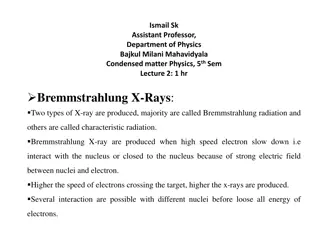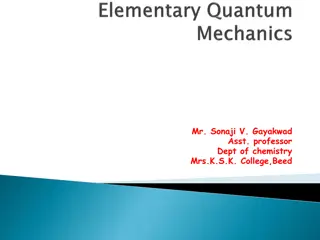Advanced Topics in B.Sc III Semester 5: Electronics, Condensed Matter Physics, Nuclear and Radiation Physics
Explore advanced concepts in Electronics-I like current and voltage sources, p-n junctions, diode biasing, rectification techniques, and transistor characteristics. Delve into Crystal Structure and Crystal Diffraction in Condensed Matter Physics, and learn about nuclear forces, radioactivity, and nuclear reactions in Nuclear and Radiation Physics.
Download Presentation

Please find below an Image/Link to download the presentation.
The content on the website is provided AS IS for your information and personal use only. It may not be sold, licensed, or shared on other websites without obtaining consent from the author. Download presentation by click this link. If you encounter any issues during the download, it is possible that the publisher has removed the file from their server.
E N D
Presentation Transcript
B.SC.III SEM5 ELECTRONICS-I 2019-20 Week 1 Concept of current and voltage sources, p-n junction, Biasing of diode, V-A characteristics. Diode equation, Breakdown diodes: Zener breakdown and avalanche breakdown, Zener diode. Week2 Rectification: half wave, full wave rectifiers and bridge rectifiers, Qualitative analysis of Filter circuits (RC LC and filters) Efficiency, Ripple factor, Voltage regulation. Voltage multiplier circuits. Week3 Junction transistor: structure and working, relation between different currents in transistors, Sign conventions. Amplifying action, Different configurations of transistor and their comparison, CB and CE characteristics. Week4 Structure, Characteristics, operation of FET, JFET and MOSFET, Pinch off voltage, Enhancement and Depletion mode, Comparison of JFETs and MOSFETs, Difference in field effect transistor and junction type transistor. Photo-conductive devices: Photo- conductive cell, Photodiode, Solar cell, LED, LCD.
B.SC.III SEM5 2019-20 CONDENSED MATTER PHYSICS-I Week 5 Crystal Structure. Symmetry operations for a two dimensional crystal. Two dimensional Bravais lattices, Three dimensional Bravais lattices" Basic primitive cells. Week 6 Crystal planes and Miller indices. Diamond and NaCI structure. Packing fraction for Cubic and hexagonal closed packed structure. Week 7 Crystal Diffraction: Bragg's Law, Experimental methods for crystal structure studies, laue equations, Reciprocal lattices of SC, BCC and FCC. Week 8 Bragg's Law in reciprocal lattice. Brillouin zones and its derivation in two dimensions, Structure factor and atomic form factor.
B.SC.III SEM5 2019-20 NUCLEAR AND RADIATION PHYSICS Week 9 Constituents of nucleus and their intrinsic properties, Qualitative facts about size, mass, density, energy, charge. Binding energy, angular momentum, magnetic moment and electric quadruple moments of the nucleus,Wave mechanical properties of nucleus, average binding energy and its variation with mass numbers. Week 10 Properties of nuclear forces, Non existence of electrons in the nucleus and neutron-proton model, Liquid drop model and semi empirical mass formula, Conditions of nuclear stability, Fermi gas model. Nuclear shell model. Experimental evidence of magic numbers and its explanation. Week 11 Radioactivity. Modes of decay and successive radioactivity. Alpha emission. Electron emission, Positron emission. Electron capture, Gamma-ray emission, Internal conversion, Qualitative discussion of alpha, beta and gamma spectra, Geiger-Nuttal rule. Week 12 Neutrino hypothesis of beta decay. Evidence of existence of neutrino, Qualitative discussion of alpha and beta decay theories, Nuclear reactions. Reaction cross section, Conservation laws. Kinematics of nuclear reaction, Q-value and its physical significance, Compound nucleus, Possible reaction with high energy particles.
B.SC.III SEM5 2019-20 Week 13 Discussion of doubts and tough topics of book Electronics-1 Classtests of book Electronics. Week 14 Discussion of doubts and tough topics of book Condensed Matter Physics-1 Classtests of book Condensed Matter Physics-1 Week15 Discussion of doubts and tough topics of book Nuclear And Radiation Physics Classtests of book Nuclear And Radiation Physics Week 16 Discussion of previous year question papers
B.SC.III SEM6 ELECTRONICS-II 2019-20 Week 1 Thyristor, SCR, TRIAC, DIAC: Construction, Characteristics and Operation; Comparison between transistors and thyristors; Difference between SCR and TRIAC. UJT: its construction, Equivalent circuit, Characteristics and parameters, uses. Week 2 Thermistor: Types, Construction, Characteristics, Uses, Advantages over other temperature sensing devices IMPATT and TRAPATT devices, PIN diode: Construction, Charatersitics, Applications. Week 3 Gunn effect and diodes: Mechanism, Characteristic, Negative differential resistivity and Domain formation Tunnel diode: Tunneling Phenomenon, Operation, Applications. Merits and Drawbacks Transistor biasing: Stabilization of operating point, Fixed bias, Collector to base bias, Bias circuit with emitter resistor, Voltage divider biasing circuit. Week 4 CE amplifier: Working and analysis using h-parameters, Equivalent circuits, Determination of current gain, Power gain, Input impedance, FET amplifier: Voltage, Current and Power gain Feed back in amplifiers: Types & advantage of negative feedback. Emitter follower as negative feed back circuit.
B.SC.III SEM 6 2019-20 CONDENSED MATTER PHYSICS-II Week 5 Lattice vibrations, Concepts of phonons, Scattering of protons by phonons. Vibration of mono-atomic, di-atomic, linear chains. Density of modes. Week 6 Einstein and Debye models of specific heat, Free electron model of metals. Free electron, Fermi gas and Fermi energy. Week 7 Band theory, Kronig-Penney Model. Metals and insulators, Conductivity and its variation with temperature in semiconductors, Fermi levels in intrinsic and extrinsic semiconductors. Week 8 Qualitative discussion of band gap in semiconductors, superconductivity, Magnetic field effect in superconductors, BCS theory. Thermal properties of superconductors
B.SC.III SEM6 2019-20 NUCLEAR AND PARTICLE PHYSICS Week9 Energy loss due to ionization (Bethe s formula), Energy loss of electrons, Bremsstrahlung, Interactions of gamma rays with matter. Radiation loss by fast electrons, Radiation length, Electron-positron annihilation. Week 10 Cyclotron. Betatron, Qualitative discussion of Synchrotron, Collider machines and linear accelerator. Week 11 Ionization chamber, Proportional counter, GM counter, Scintillation counter, Solid state detectors, Elementary particles and their masses, Decay modes. Week 12 Classification of these particles, types of interactions. Conservation laws and quantum numbers, Concepts of isospin. Strangeness, Parity, Charge conjugation. Antiparticles, Gell-Man method, Decay and strange particles. Particle symmetry, Introduction to quarks and qualitative discussion of the quark model.
B.SC.III SEM6 2019-20 Week 13 Discussion of doubts and tough topics of book Electronics-1 Classtests of book Electronics. Week 14 Discussion of doubts and tough topics of book Condensed Matter Physics-1 Classtests of book Condensed Matter Physics-1 Week15 Discussion of doubts and tough topics of book Nuclear And Radiation Physics Classtests of book Nuclear And Radiation Physics Week 16 Discussion of previous year question papers
B.SC.II SEM3 2019-20 STATISTICAL PHYSICS AND THERMODYNAMICS-I Week 1 Basic ideas of statistical physics, Scope of statistical physics, Basic ideas about probability, distribution of four distinguishable particles in two compartment of equal size. Concept of macro states, microstates, thermodynamic probability. Week 2 Effects of constraints on the system, Distribution of n particles in two compartments, Deviation from the state of maximum probability, equilibrium state of dynamic system, Distribution of distinguishable n particles in k compartments of unequal sizes. Week 3 Phase space and its division into elementary cells, Three kinds of statistics. The basic approach in the three statistics, Maxwell Boltzman (MB) statistics applied to an ideal gas in equilibrium. Experimental verification of Maxwell Boltzman law of distribution of molecular speeds. Week 4 Need for quantum statistics-Bose-Einstein (B.E.) statistics, Derivation of Planck s law of radiation, Deduction of Wien s displacement law and Stefan s law from Planck s law, Fermi-Dirac (F.D.) statistics, Comparison of M.B., B.E. and F.D. statistics.
B.SC.II SEM3 2019-20 QUANTUM MECHANICS -I Week 5 Formalism of Wave Mechanics: Brief introduction to need and development of quantum mechanics, Wave-particle duality, de-Broglie hypothesis, Complimentarity and uncertainty principle, Gaussian wave-packet, Schrodinger equation for a free particle, operator correspondence and equation for a particle subject to forces. Normalization and probability Week 6 Interpretation of wave function, Super position principle, Expectation value, probability current and conservation of probability, Admissibility conditions on the wave function. Ehrenfest theorem, Fundamental postulates of wave mechanics, Eigen functions and eigen values. Operator formalism, Orthogonal systems, Expansion in eigen functions, Hermitian operators. Simultaneous eigen functions. Equation of motion. Week 7 Problems in one and three dimensions: Time dependent Schrodinger equation. Application to stationary states for one dimension, Potential step, Potential barrier, Rectangular potential well, Degeneracy, Orthogonality, Linear harmonic oscillator,. Week 8 Schrodinger equation for spherically symmetric potential, Spherical harmonics. Hydrogen atom energy levels and eigen functions. Degeneracy, Angular momentum.
B.SC.II SEM3 OPTICS Week 9 2019-20 Interference: Concept of coherence, Spatial and temporal coherence. Coherence time, Coherence length, Area of coherence, Conditions for observing interference fringes, Interference by wave front division and amplitude division,. Week 10 Michelson s interferometer working, Principle and nature of fringes, Interference in thin films, Role of interference in anti-reflection and high reflection dielectric coatings. Multiple beam interference, Fabry-Perot interferometer, Nature of fringes, Newton Rings Week 11 . Diffraction: Huygens-Fresnel theory, half-period zones, Zone plates, Distinction between Fresnel and Fraunhofer diffraction, Fraunhofer diffraction at rectangular and circular apertures, Effects of diffraction in optical imaging, resolving power of telescope. The diffraction grating, its use as a spectroscopic element and its resolving power. Week 12 Polarization: Concept and analytical treatment of un-polarized, plane polarized and elliptically polarized light. Double refraction, Nicol prism, Sheet polarizer, Retardation plates, Production and analysis of polarized light (quarter and half wave plates).
B.SC.II SEM3 2019-20 Week 13 Discussion of doubts and tough topics of book Statistical Physics and Thermodynamics-I Classtests of book Statistical Physics and Thermodynamics-I Week 14 Discussion of doubts and tough topics of book Quantum Physics-I Classtests of book Quantum Physics-I Week15 Discussion of doubts and tough topics of book Optics Classtests of book Optics Week 16 Discussion of previous year question papers
2019-20 B.SC.II SEM4 STATISTICAL PHYSICS AND THERMODYNAMICS-II Week 1 Statistical definition of entropy, Change of entropy of a system, Additive nature of entropy, Law of increase of entropy, Reversible and irreversible process and their examples. Work done in a reversible process. Examples of increase of entorpy in natural processes, Entropy and disorder. Week 2 Brief review of terms and laws of thermodynamics, Carnot s cycle, Entropy changes in Carnot cycle. Applications of thermodynamics to thermoelectric effect. Change of entropy along a reversible path in a P.V. diagram, Entropy of a perfect gas, Equation of state of an ideal gas from simple statistical consideration, Heat death of the universe. Week 3 Derivation of Maxwell s thermo dynamical relations, Cooling produced by adiabatic streching, Adiabatic compression, Change of internal energy with volume, specific heat at constant pressure and constant volume, Expression for Cp -Cv . Week 4 Change of state and Clayperon equation, Thermo dynamical treatment of Joule-Thomson effect, Use of Joule-Thomson effect, liquefiction of helium, Production of very low temperature by adiabatic demagnetization.
B.SC.II SEM 4 2019-20 QUANTUM MECHANICS -II Week 5 One Electron Atomic Spectra: Excitation of atom with radiation. Transition probability, Spontaneous transition, Selection rules and life time, Spectrum of hydrogen atom. Frank Hertz Experiment, Line structure, Normal Zeeman effect. Week 6 Electron spin, Stern Gerlach experiment, Spin orbit coupling (electron magnetic moment, total angular momentum),Hyperfine structure, Examples of one electron systems, Anomalous,Zeeman effect, Lande-g factor (sodium D-lines). Week 7 Many Electron System Spectra: Exchange symmetry of wave functions, exclusion principle, Shells, Sub shells in atoms, atomic spectra (Helium), L.S. coupling, Selection rules, Regularities in atomic spectra, Interaction energy. Week 8 X-ray spectra, Mosley law, Absorption spectra, Auger effect. Molecular bonding, Molecular spectra, Selection rules, Symmetric structures, Rotational, vibrational electronic level and spectra of molecules, Raman spectra.
B.SC.II SEM 4 LASERS 2019-20 Week 9 Laser Fundamentals : Derivation of Einstein s relations. Concept of stimulated emission and population inversion. Broadening of spectral lines, natural, collision and Doppler broadening. Line width, Line profile. Week 10 Absorption and amplification of a parallel beam of light passing through a medium. Threshold condition, Introduction of three level and four level laser schemes, elementary theory of optical cavity, Longitudinal and transverse modes. Week 11 Laser Systems : types of lasers, Ruby and Nd: YAG lasers, He-Ne and CO2 lasers-construction, mode of creating population inversion and output characterstics. Semiconductor lasers. Week 12 Dye lasers, Q-switching, Mode locking, Applications of lasers a general outline. Basics of holography.
B.SC.II SEM 4 2019-20 Week 13 Discussion of doubts and tough topics of book Statistical Physics and Thermodynamics-II Classtests of book Statistical Physics and Thermodynamics-II Week 14 Discussion of doubts and tough topics of book Quantum Physics-II Classtests of book Quantum Physics-II Week15 Discussion of doubts and tough topics of book Lasers Classtests of book Lasers Week 16 Discussion of previous year question papers
B.SC I SEM- I MECHANICS-I 2019-20 Week 1 Cartesian and spherical polar co-ordinate systems, area, volume, displacement, velocity and acceleration in these systems, Solid angle, Various forces in Nature Breif intoduction Week 2 Centre of mass, Equivalent one body problem, Central forces, Equation of motion under central force, Equation of orbit in inverse square, Force field and turning points, Kepler laws and their derivations. Week 3 Relationship of conservation laws and symmetries of space and time. Inertial frame of reference. Coriolis force and its applications. Variation of acceleration due to gravity with latitude. Focault pendulum (qualitative). Week 4 Elastic collision in Laboratory and C.M.system, velocities, angels and energies, Cross section of elastic scattering . Rutherford scattering (qualitative).
2019-20 B.SC.I SEM- 1 ELECTRICITY AND MAGNETISM -I Week 5 Basic ideas of vector calculus,Gradient, Divergence, curl and their physical significance, Coulomb s law in vector form, long uniformly charged wire, Charged disc. Stokes's theorem and its applications in electrostatic field, curl E= 0. Week 6 Electric field as gradient of scalar potential. Calculation of E due to a point charge and dipole from potential. Potential due to arbitrary charge distribution and multipole moments. Poission and Laplace's equations and their solutions in Cartesian and concept of electrical images. Week 7 Calculation of electric potential and field due a point charge placed near an infinitely conducting sheet. Current and current density, equation of continuity. Microscopic form of Ohm's Law. (J= E) and conductivity. Failure of Ohm's Law. Week 8 Invariance of charge. E in different frames of reference. Field of a point charge moving with constant velocity. Interaction between moving charges and force between parallel currents.
B.SC.I SEM -I VIBRATION AND WAVES-I Week 9 2019-20 Simple harmonic motion, energy of a Simple Harmonic Oscillation (SHO). Compound pendulum, Electrical oscillations. Transverse vibrations of a mass on a string, composition of two perpendicular SHM of same period and of period ratio 1 : 2. Week 10 Anharmonic oscillations. Decay of free vibrations due to damping. Differential equation of motion, types of damping. Determination of damping co-efficient- logarithmic decrement, relaxation time and Q-Factor. Electromagnetic damping (Electrical oscillator). Week 11 Differential equation for forced mechanical and electrical oscillators. Transient and steady state oscillation. Displacement and velocity variation with driving force frequency, variation of phase with frequency resonance. Week 12 Power supplied to an oscillator and its variation with frequency, Q value of a forced oscillator and band width. Q-value as an amplication factor of low frequency response.
B.SC.I SEM I 2019-20 Week 13 Discussion of doubts and tough topics of book Mechanics-I Classtests of book Mechanics-I Week 14 Discussion of doubts and tough topics of book Electricity and Magnetism-I Classtests of book Electricity and Magnetism-I Week15 Discussion of doubts and tough topics of book Vibrations and Waves-I Classtests of book Vibrations and Waves-I Week 16 Discussion of previous year question papers
B.SC I SEM- II MECHANIC S-II Week 1 2019-20 Rigid body motion: Rotational motion, principal moments and axes. Euler's equations; precession and elementary gyroscope. Week 2 Galilean transformation and Invariance, Non-Inertial frames, concept of stationary universal frame of reference and ether. Michelson-Morley experiment and its result. Week 3 Postulates of special theory of relativity. Lorentz transformations, Observer and viewer in relativity. Relativity of simultaneity. Length, Time, Velocities,Relativistic Doppler effect. Week 4 Variation of mass with velocity, mass-energy equivalence, rest mass in an inelatic collision, Relativistic momentum and energy, their transformation, concepts of Minkowski space, four vector formulation.
B.SC.I SEM- II 2019-20 ELECTRICITY AND MAGNETISM -II Week 5 Behaviour of various substances in magnetic field. Definition of M and H and their relation to free and bound currents. Permeability and susceptibilities and their inter- relationship. Orbital motion of electrons and diamagetism. Electron spin and paramagnetism. Week 6 Ferromagnetism. Domain theory of Ferromagnetism. Hysteresis Loss. Magnetisation curve Ferrites. Lorentz's force. Definition of B, Biot Savart's Law and its applications to long straight wire, circular current loop and solenoid. Ampere's Circuital law and its applications. Week 7 Divergence and curl of B. Hall effect, expression and co-efficient. Vector potential, Definition and derivation of current density and its use in calulation of change in magnetic field at a current sheet. Transformation equations for E and B from one frame to another. Week 8 Faraday's Law and EM induction. Displacement current. Maxwell's equations. Mutual inductance and reciprocity theorem. Self inductance L for solenoid. Coupling of Electrical circuits. Analysis of LCR series and parallel resvonant circuits. Q-factor. Power consumed Power factor.
2019-20 B.SC.I SEM -II VIBRATION AND WAVES-II Week 9 Stiffness coupled oscillators. Normal co-ordinates and normal modes of vibration. Inductance coupling of electrical oscillators, Types of waves, Wave equation (transverse) and its solution, The string as a forced oscillator. Week 10 Characteristic impedance of a string. Impedance matching. Reflection and transmission of energy, Reflection and Transmission Energy, Reflection and transmission of string, wave and group velocity. Standing waves on a string of fixed length. Energy of vibrating energy string,wave and group velocity. Week 11 Physical interpretation of Maxwell's equations. Electromagnetic waves and wave equation in a medium having finite permeability and permittvity but with conductivity =0. Pointing vector. Impedance of a dielectric to EM waves, EM waves in a conducting medium and skin depth. Week12 EM waves velocity in a conductor an anomalous dispersion. Response of a conducting medium of EM waves. Reflection and transmission of EM waves at a boundary of two dielectric media for normal incidence. Reflection of EM waves from the surface of a conductor at normal incidence.
B.SC.I SEM II 2019-20 Week 13 Discussion of doubts and tough topics of book Mechanics-II Classtests of book Mechanics-II Week 14 Discussion of doubts and tough topics of book Electricity and Magnetism-II Classtests of book Electricity and Magnetism-II Week15 Discussion of doubts and tough topics of book Vibrations and Waves-II Classtests of book Vibrations and Waves-II Week 16 Discussion of previous year question papers
